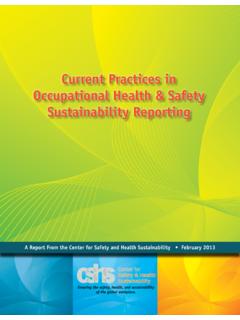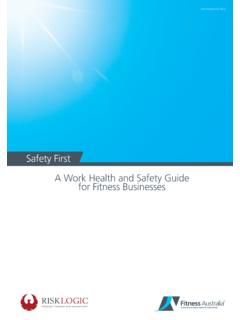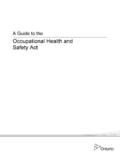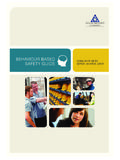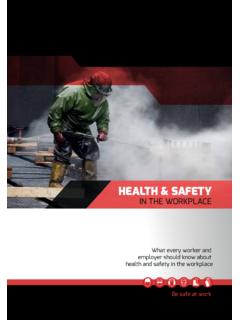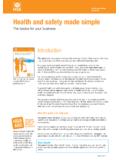Transcription of CSHS Best Practice Guide for Occupational Health and ...
1 CSHS best Practice Guide for Occupational Health and safety in Sustainability Reports2 AcknowledgementsThis document was developed by the Center for safety and Health Sustainability and their Advisory Council. The principal author was Zack 2016 Center for safety and Health Sustainability You may freely distribute this document to any interested party in full without changes or modifications without restriction. Excerpts and quotations should include an acknowledgement of the Guide is intended for large organizations that are already publishing or will publish (in print or on-line) publically available sustainability reports and/or Occupational Health and safety (and/or environmen-tal) reports. It may not be feasible for small organizations to meet all the reporting recommendations, but it can serve as guidance for best corporate reporting landscape has dramatically changed over the last several years.
2 Inves-tors and other key stakeholders are demanding more and better information on corporate per-formance. These developments have important implications for Occupational Health and safety (OHS) reporting. The Center for safety and Health Sustainability is committed to helping your organization ne-gotiate these changes and meet the widening needs of investors and stakeholders. It is with this end in mind that CSHS has launched an initiative to standardize OHS reporting. CSHS views this campaign as a critical step in improving OHS performance and, ultimately, preventing worker injuries, illnesses, and fatalities. CSHS represents over 100,000 OHS professionals in over 70 countries. The metrics proposed by CSHS, developed through global collaboration among the world s largest Occupational Health and safety professional bodies, are not radical they are currently being used in some format by a multitude of organizations around the world, meaning they are standards of performance which are already accepted, understood, and operationalized by those managing Health and safety at work.
3 The CSHS metrics have a broader scope and wider applicability in assessing workplaces worldwide across all geographical boundaries. In addition to addressing OHS needs at large organizations, they are more applicable to small and medium-sized enterprises, extend coverage to temporary or fixed duration contract workers, and increase focus on workers for suppliers in the developing world. It presents the recommended minimum level of OHS report-ing that would be applicable to all of the GuideThis Guide is divided into two sections: Es-sential Elements and Optional Elements. The Essential Elements encourage analysis and comparison of organizations, currently a problem in evaluating OHS performance. These Essential Elements are applicable to all sectors and categories, including but not limited to manufacturing, distribution, and medical care, non-governmental organizations (NGOs), consulting and government.
4 Organi-zations that combine safety , Health (industrial hygiene), and environmental elements in the same section of the sustainability reporting will find our metrics applicable. The Optional Elements are recommended, but not required for meeting the intent of this Guide . However, they are recommended as important information which will strengthen the reader s ability to judge the quality of OHS efforts for the reporting entity. The reporter is encouraged to include as many of these Optional Elements of information as pos-sible. There are six optional categories, which include OHS targets, capital investments, worker involvement, training, risks and ad-ditional Guide supplements other recommended sustainability reporting guides and reporting requirements from organizations such as the Global Reporting Initiative (GRI), the new EU Directive on Disclosure of Non-Financial and Diversity Information, the Sustainability Ac-counting Standards Board (SASB), the United Nations Global Compact (UNGC), Responsi-ble Care, the International Integrated Report-ing Council (IIRC) recommendations and vari-ous other industry specific, governmental and non-governmental requirements.
5 The metrics recommended by CSHS do not conflict with requirements from other reporting guidelines. The scope of the Guide is workplace Health and safety reporting for sites owned by or operated for the organization. Reporting should rep-resent the overall organization at the highest administrative level and not be concerned with minor differences in individual operating units ( , headquarters and not individual sites). Where operational standards are sig-nificantly different from corporate standards, however, these should be reported separately or should consider workplace Health and safety as material to their stake-holders. Every organization should consider itself within the scope and materiality of these guidelines.
6 Organizations should consider workplace Health and safety as material to their stakeholders. Every organization should consider itself within the scope and materiality of these guidelines. 4 Essential ElementsDESCRIPTIVE REPORTING REQUIREMENTSThe Introduction and Summary of Key PointsThe beginning of your OHS report should include an introduction and summary of key points, providing the reader with an overview of your OHS programs and key performance measures. This might include information on both performance against established continu-al improvement targets and a brief description of any new targets as Structure and Reporting RelationshipsThe report should include information on the organizational structure and reporting rela-tionships for the central or corporate OHS function(s), whether on an indirect or direct basis.
7 It should include: OHS staffing levels A general description of reporting rela-tionship, including which department the OHS function reports to ( , legal, operations, supply chain, human resourc-es, financial, and the position to whom it reports directly (an officer of the company such as the CEO or President, Director of a department), and Whether a member of the organization s Board of Directors has direct oversight responsibility for the OHS function. If the organizational designation includes other functions such as environment, quality and security, etc., these should be noted. The Scope of the OHS ProgramsThis section should describe the OHS pro-gram s scope of coverage and should include all organizational sites, facilities, business units, business operations, suppliers, and con-tractors.)
8 The report should note any limitations or exclusions, including any subsidiaries, joint ventures (or other partnerships), and recent acquisitions or divestments. If this information is already presented in other areas of the sustainability reporting, it does not need to be repeated in this section. OHS Policy or Codes of ConductThe section should provide a description or summary of the top-level OHS policy and/or codes of conduct ( , Corporate OSH policy statement or Vendor Code of Conduct), indi-cating whether the policy and codes are ap-plicable to the entire organization. Policies and codes unique to particular operating divisions or business units should also be identified. It is not necessary to describe multiple policies or codes of conduct, which can be listed with an internet or other reference Management SystemsThis section of the report should describe the organization s OHS management system.
9 This could be a proprietary approach or the use of a nationally or internationally recognized standard or guideline. Examples of national guidelines include: The United States Occupational safety and Health Administration (OSHA) Vol-untary Protection Program (VPP) The US ANSI/AIHA/ASSE Z10-2012 Oc-cupational Health & safety Management Systems standard, and The Canadian version, CAN/CSA-Z1000-14 - Occupational Health and safety managementExamples of internationally recognized pro-grams include: The OHSAS 18001 Occupational Health and safety Management standard The forthcoming ISO/DIS 45001 Occu-pational Health and safety management systems standard, and The ILO s Guidelines on Occupational safety and Health Management Systems.
10 5If the organization utilizes: A nationally/internationally recognized management system, identify the system used. A custom management system, describe the key components of the system and indicate whether it meets nationally/in-ternationally recognized standards. If the management system has been registered or certified by a third party auditor, the date of certification or registration should be provided in general, but not for each site. If some sites are not registered or certified, this should be noted as well. This can be expressed as a percentage of accredited sites or as the actual numbers for each category. OHS Program and Performance AuditingThis section should detail the organization s approach to OHS auditing with regard to the OHS program itself and its performance.
